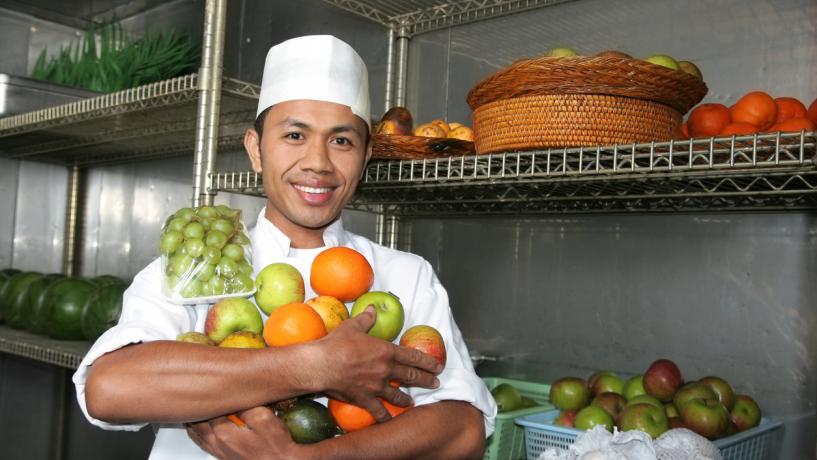
When food unnecessarily spoils, your food costs skyrocket, making it harder for you to keep customer prices fair and competitive. It’s common for staff to cut corners when storing food, some examples are:
- not putting food away in the correct order
- stacking raw meats and poultry above prepared foods
- forgetting to check food for physical contamination
- storing food near or with cleaners, sanitisers and other chemicals
Mistakes happen, and eventually, the simplest of food storage errors will cost your business hundreds (perhaps thousands) of dollars. When storing food safely isn’t a priority, typical costs incurred by businesses are:
- health Inspection fines
- increased food costs (replacing spoiled food)
- compensating customers who claim food poisoning
Making simple changes to how your business stores food not only saves you money but can protect your business and your customers from a food-borne illness. Our five food storage tips should be part of your food safety plan and will save you time and money.
Tip One: Identifying Potentially Hazardous Foods
The storage of potentially hazardous foods is always a priority. Meats, poultry, seafood, dairy and even cooked rice and pasta are all examples of potentially hazardous foods. These foods, when not stored properly, will grow and spread life-threatening bacteria at a higher rate than most other foods.
Typically, most of your food budget is spent on potentially hazardous foods. Taking the time to handle these items will save your business money. The cost of losing a case of fresh salmon or chicken breasts can be the reason your business doesn’t turn a profit that day.
Tip Two: Prioritising Food Deliveries
When you receive deliveries from suppliers, always put food away in the following order:
- Potentially hazardous refrigerated foods
- Frozen foods
- Other refrigerated items
- Dry goods
It’s common for Food Handlers to start putting away dry goods, get distracted, and then return later to store refrigerated and frozen foods as they can sometimes be more work to put away. Storing dry foods first means that hazardous foods may sit for too long in the Temperature Danger Zone.
If you haven’t already, explain to your staff that refrigerated and frozen food not put away immediately are at risk for entering the Temperature Danger Zone and spoiling.
Tip Three: Check for Physical Contamination
Physical food contamination occurs when actual objects soil the food, for example, pests, dirt, glass or hair.
Before storing any food item, check for things that could physically contaminate the food, for example, dirt, unnecessary stamps or labels on food, staples, or even nails.
We recommend storing products in their original packaging. However, if the original packaging is damaged then use food grade containers to store food. A food grade container is:
- cleaned and sanitised
- labelled with the product name
- contains the received and expiry date
Note: The exception to this rule, fresh fruits and vegetables should always be removed from cardboard containers and placed into food grade containers.
Tip Four: Food Placement
Use food in the order it was received. Food Handlers may try to save time by not rotating stocked food. Using the First in First Out (FIFO) system prevents food spoiling or using expired food.
In addition to FIFO, store potentially hazardous foods in a specific order in your coolers. The rule for refrigerator food storage is low-risk foods up top, high-risk foods down low. For example:

Storing potentially hazardous foods above ready-to-eat foods may cause cross contamination - one of the highest and most easily preventable causes of food poisoning.
Tip Five: Don’t Crowd Food
When you crowd food into storage areas, you make it difficult for staff to:
- follow the FIFO method
- check for signs of pest infestations
- clean and sanitise food storage areas
When food deliveries arrive, and there’s no place to put them, it’s typical for Food Handlers to store food everywhere and anywhere, sometimes even with cleaning products.
Always remind Food Handlers of the extreme danger that commercial cleaners, sanitisers and other chemicals pose to food. It’s easy for chemicals to drip or seeps into packaging, making food ingredients toxic.
We recommend keeping a close watch on food inventory levels. You’re better to cancel or change the date of an order than to try and find space for food.
Adopting New Food Safety Practices
When making any change to how your business operates, the most challenging task can be getting your Food Handler’s to commit to new food safety procedures. It can be hard for them to see how their day-to-day actions have severe consequences, especially when it comes to food safety.
The quickest and easiest way to get you staff to make changes to how they handle food is to educate them on why food safety is paramount - to protect the health and wellness of your customers.
AIFS Food Safety Supervisor and Food Handler Certification courses teach your team how to legally and correctly handle food and why - to protect customers from the spread of food-borne illness.




